
Venus is a Roman goddess, whose functions encompass love, beauty, desire, sex, fertility, prosperity, and victory. In Roman mythology, she was the ancestor of the Roman people through her son, Aeneas, who survived the fall of Troy and fled to Italy. Julius Caesar claimed her as his ancestor. Venus was central to many religious festivals, and was revered in Roman religion under numerous cult titles.
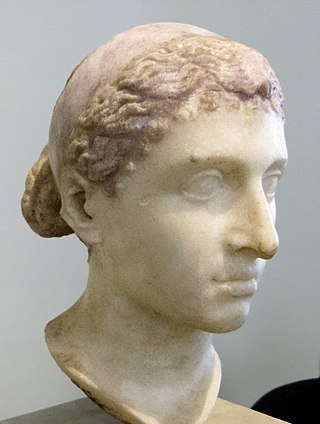
Cleopatra VII Philopator was Queen of the Ptolemaic Kingdom of Egypt from 51 to 30 BC, and its last active ruler. A member of the Ptolemaic dynasty, she was a descendant of its founder Ptolemy I Soter, a Macedonian Greek general and companion of Alexander the Great. After the death of Cleopatra, Egypt became a province of the Roman Empire, marking the end of the second to last Hellenistic state and the age that had lasted since the reign of Alexander. Her native language was Koine Greek, and she was the only Ptolemaic ruler to learn the Egyptian language.
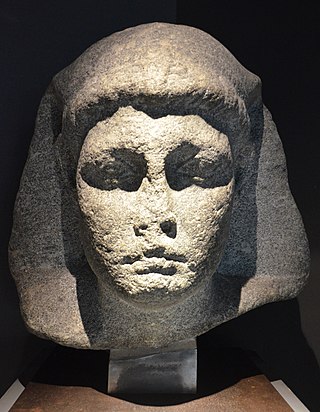
Ptolemy XV Caesar, nicknamed Caesarion, was the last pharaoh of Ptolemaic Egypt, reigning with his mother Cleopatra from 2 September 44 BC until her death by 12 August 30 BC, then as sole ruler until his death was ordered by Octavian.

The Diadumenos ("diadem-bearer"), together with the Doryphoros, are two of the most famous figural types of the sculptor Polyclitus, forming a basic pattern of Ancient Greek sculpture that all present strictly idealized representations of young male athletes in a convincingly naturalistic manner.

The Capitoline Museums are a group of art and archaeological museums in Piazza del Campidoglio, on top of the Capitoline Hill in Rome, Italy. The historic seats of the museums are Palazzo dei Conservatori and Palazzo Nuovo, facing on the central trapezoidal piazza in a plan conceived by Michelangelo in 1536 and executed over a period of more than 400 years.

The Aphrodite of Knidos was an Ancient Greek sculpture of the goddess Aphrodite created by Praxiteles of Athens around the 4th century BC. It is one of the first life-sized representations of the nude female form in Greek history, displaying an alternative idea to male heroic nudity. Praxiteles' Aphrodite is shown nude, reaching for a bath towel while covering her pubis, which, in turn leaves her breasts exposed. Up until this point, Greek sculpture had been dominated by male nude figures. The original Greek sculpture is no longer in existence; however, many Roman copies survive of this influential work of art. Variants of the Venus Pudica are the Venus de' Medici and the Capitoline Venus.
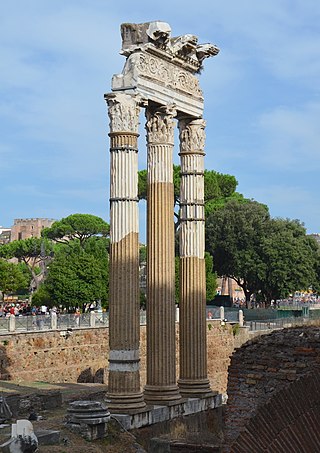
The Temple of Venus Genetrix is a ruined temple in the Forum of Caesar, Rome, dedicated to the Roman goddess Venus Genetrix, the founding goddess of the Julian gens. It was dedicated to the goddess on September 26, 46 BCE by Julius Caesar.

The Venus de' Medici or Medici Venus is a 1.53 m tall Hellenistic marble sculpture depicting the Greek goddess of love Aphrodite. It is a 1st-century BC marble copy, perhaps made in Athens, of a bronze original Greek sculpture, following the type of the Aphrodite of Knidos, which would have been made by a sculptor in the immediate Praxitelean tradition, perhaps at the end of the century. It has become one of the navigation points by which the progress of the Western classical tradition is traced, the references to it outline the changes of taste and the process of classical scholarship. It is housed in the Uffizi Gallery, Florence, Italy.

The Gardens of Maecenas, or Horti Maecenatis, constituted the luxurious ancient Roman estate of Gaius Maecenas, an Augustan-era imperial advisor and patron of the arts. The property was among the first in Italy to emulate the style of Persian gardens. The walled villa, buildings, and gardens were located on the Esquiline Hill, atop the agger of the Servian Wall and its adjoining necropolis, as well as near the Horti Lamiani.
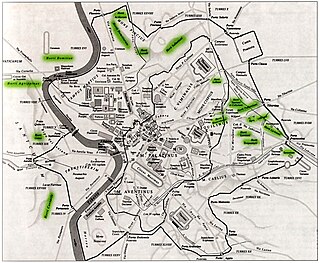
The Horti Liciniani was a luxurious complex of an ancient Roman villa with large gardens and outdoor rooms originally belonging to the gens Licinia. It was located in Rome on the Esquiline Hill between via Labicana and via Prenestina, close to the Aurelian walls. They bordered the Horti Tauriani to the north and the Horti Pallantiani and Horti Epaphroditiani to the west.
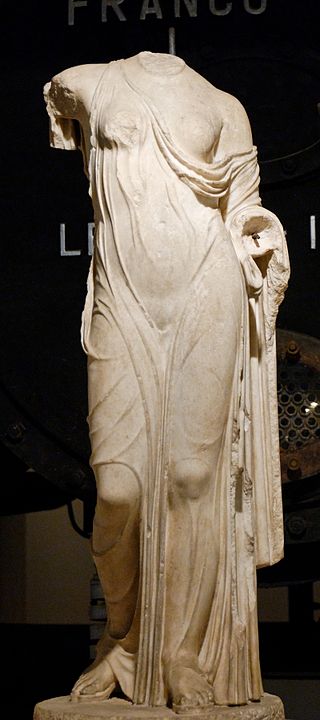
The Venus Genetrix is a sculptural type which shows the Roman goddess Venus in her aspect of Genetrix, as she was honoured by the Julio-Claudian dynasty of Rome, which claimed her as their ancestor. Contemporary references identify the sculptor as a Greek named Arcesilaus. The statue was set up in Julius Caesar's new forum, probably as the cult statue in the cella of his temple of Venus Genetrix. Through this historical chance, a Roman designation is applied to an iconological type of Aphrodite that originated among the Greeks.

The Venus of Arles is a 1.94-metre-high (6.4 ft) sculpture of Venus at the Musée du Louvre. It is in Hymettus marble and dates to the end of the 1st century BC.

The Townley Venus is a 2.14 m (7 ft) high 1st or 2nd century AD Roman sculpture in Proconnesian marble of the goddess Venus, from the collection of Charles Towneley. It was bought by him from the dealer Gavin Hamilton, who excavated it at Ostia in 1775. He shipped it to England in two pieces to get it past the Papal antiquaries' customs checks.

The death of Cleopatra VII, the last ruler of Ptolemaic Egypt, occurred on either 10 or 12 August, 30 BC, in Alexandria, when she was 39 years old. According to popular belief, Cleopatra killed herself by allowing an asp to bite her, but for the Roman-era writers Strabo, Plutarch, and Cassius Dio, Cleopatra poisoned herself using either a toxic ointment or by introducing the poison with a sharp implement such as a hairpin. Modern scholars debate the validity of ancient reports involving snakebites as the cause of death and if she was murdered or not. Some academics hypothesize that her Roman political rival Octavian forced her to kill herself in a manner of her choosing. The location of Cleopatra's tomb is unknown. It was recorded that Octavian allowed for her and her husband, the Roman politician and general Mark Antony, who stabbed himself with a sword, to be buried together properly.

The Bust of Cleopatra VII is a granite bust currently on display in the Gallery of Ancient Egypt at the Royal Ontario Museum (ROM). It is believed to have been discovered in Alexandria, Egypt at the site of Cleopatra's sunken palace on the island of Antirhodos. The bust was purchased by the ROM's founder Charles Trick Currelly while on expedition in Egypt in the early 20th Century.

The Department of Egyptian Antiquities of the Louvre is a department of the Louvre that is responsible for artifacts from the Nile civilizations which date from 4,000 BC to the 4th century. The collection, comprising over 50,000 pieces, is among the world's largest, overviews Egyptian life spanning Ancient Egypt, the Middle Kingdom, the New Kingdom, Coptic art, and the Roman, Ptolemaic, and Byzantine periods.

The reign of Cleopatra VII of the Ptolemaic Kingdom of Egypt began with the death of her father, Ptolemy XII Auletes, by March 51 BC. It ended with her suicide in August 30 BC, which also marked the conclusion of the Hellenistic period and the annexation of Egypt into a Roman province. In the style of her Greek predecessors, Cleopatra reigned over Egypt and other territories as an absolute monarch, although the Roman Republic frequently interfered in its internal affairs. Her personal rule of Egypt was characterized by a continued reliance on agriculture, extensive trade and conflict with other states, the tackling of corruption, strategic management of the bureaucracy, and ambitious building projects.

Roman Republican art is the artistic production that took place in Roman territory during the period of the Republic, conventionally from 509 BC to 27 BC.

The race of Cleopatra VII, the last active Hellenistic ruler of the Macedonian-led Ptolemaic Kingdom of Egypt, has caused some debate in scholarly and non-scholarly circles. For example, the article "Was Cleopatra Black?" was published in Ebony magazine in 2002. Mary Lefkowitz, Professor Emerita of Classical Studies at Wellesley College, traces the main origins of the Black Cleopatra claim to the 1946 book by J.A. Rogers called "World's Great Men of Color", although noting that the idea of Cleopatra as black goes back to at least the 19th century. Lefkowitz refutes Rogers' hypothesis, on various scholarly grounds. The black Cleopatra claim was further revived in an essay by afrocentrist John Henrik Clarke, chair of African history at Hunter College, entitled "African Warrior Queens." Lefkowitz notes the essay includes the claim that Cleopatra described herself as black in the New Testament's Book of Acts – when in fact Cleopatra had died more than sixty years before the death of Jesus Christ.























